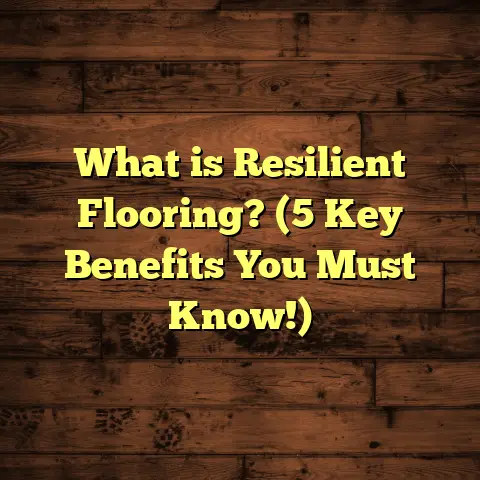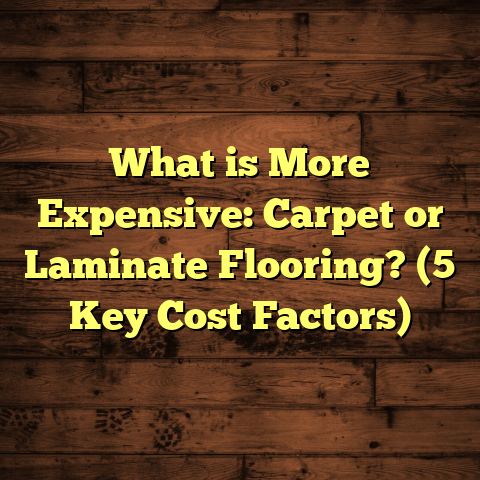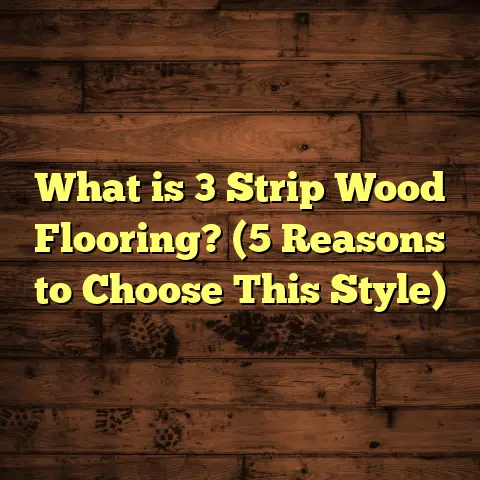What is an Unsealed Wood Floor? (5 Reasons to Consider!)
Making a great first impression when someone walks through your door often comes down to the details,
and the floor is one of the very first things they notice. I’ve spent years working with all kinds of wood
floors, and one topic that keeps coming up is the choice between sealed and unsealed wood floors.
You might be wondering, what exactly is an unsealed wood floor? And why would anyone choose it over
a sealed option? Let me share what I’ve learned through hands-on experience, a bit of research, and lots
of conversations with homeowners and experts alike.
What Is an Unsealed Wood Floor?
An unsealed wood floor is exactly what it sounds like: a natural wood surface that hasn’t been coated
with any protective finish like polyurethane, varnish, or wax. It’s raw wood exposed to the air, showing
off its natural grain, texture, and color without any glossy or matte layers over it.
When I first started in flooring, almost all wood floors I worked on were sealed right after installation.
That was the industry standard—seal to protect the wood from moisture, stains, and wear. But over time,
I began noticing a rising interest in floors that felt more “real” and less artificial. So I decided to get my
hands dirty with unsealed floors to see what the fuss is about.
Most people are familiar with sealed floors because they’re common—these finishes protect wood from
spills, scratches, and dirt. But an unsealed floor leaves the wood in its bare state, which means it can
absorb moisture, oils, and dirt much easier. This might sound risky at first, but there are reasons why some
people prefer this look and feel.
From my experience, unsealed floors offer a unique connection to the wood’s character that sealed floors
can sometimes mask. The texture feels more organic underfoot, and you get a more authentic sense of
the wood’s history and aging process.
How Are Unsealed Floors Made?
Unsealed floors come from wood planks that are sanded smooth but not finished. Sometimes they get
a light rubbing of natural oil or wax that seeps into the wood but doesn’t form a barrier on top. This oiling
is more about nourishing the wood than sealing it.
The wood species you choose matters a lot here. Hardwoods like oak, maple, or walnut work well as
unsealed floors because they’re dense and less prone to damage from moisture or dents. Softer woods
like pine or fir may require more care.
Comparing Sealed vs. Unsealed Wood Floors: Which One Works?
I’ve installed both sealed and unsealed floors in homes, and I’ve seen how each performs over time. Let me break down my observations:
- Sealed Wood Floors
These are easier to clean since spills bead on the finish. They resist stains better and protect against scratches. However, they sometimes feel less “alive.” The smooth surface can look plastic-like if the wrong finish is used. Also, once sealed, any damage means sanding down and refinishing, which can be a big job. - Unsealed Wood Floors
They demand more care to prevent moisture damage or staining but offer a rich, tactile experience. Over time, the wood develops a natural patina, telling a story unique to the space. You’ll notice dents and marks become part of the character rather than blemishes.
Here’s a little real-world insight: I worked on a project for a client who wanted that rustic farmhouse vibe. We opted for unsealed oak planks that were oiled lightly but not fully sealed. Over two years, the floor developed warm tones and subtle wear patterns that the client absolutely loved. It wasn’t perfect by traditional standards but felt cozy and lived-in.
5 Reasons Why You Might Choose an Unsealed Wood Floor
1. Authentic Natural Look and Feel
When you walk barefoot on an unsealed wood floor, you feel every groove and grain. It’s like the floor breathes with the house — no plastic-like barrier getting in the way.
Research shows that natural textures indoors can improve mood and reduce stress levels. In fact, studies by environmental psychologists suggest that tactile surfaces like raw wood increase feelings of comfort and warmth in living spaces.
Beyond science, I remember installing an unsealed cherry wood floor in a client’s beach house where the natural knots and slight imperfections gave it a storybook charm. The homeowners loved how their floors felt alive under foot—almost like a connection to nature inside their home.
2. Unique Aging Process
With sealed floors, you get a consistent look for years until the finish wears off. But unsealed floors age naturally with use—scratches, dents, and color changes add personality.
I’ve seen old farmhouses where the unsealed pine floors tell stories through their marks — decades of life captured in the wood itself. This evolving character is something you just don’t get with sealed floors.
One homeowner I know said their unsealed floors look like a “living memory book” where every scratch is a story: kids playing, pets running around, family dinners — all etched into the wood itself.
3. Repair and Maintenance Flexibility
Sealed floors often require specialized products for maintenance and professional refinishing when damaged. Unsealed floors can be spot-treated or lightly sanded without worrying about matching finish layers.
That said, unsealed floors do need regular care — like oiling or waxing — to prevent drying out or staining. But many homeowners enjoy this hands-on approach; it keeps them connected to their home’s upkeep.
I recall advising a customer who was hesitant about maintenance. After I explained how easy it was to re-oil small sections instead of refinishing an entire sealed floor every decade or so, they felt relieved and chose unsealed.
4. Environmental Considerations
Sealed floors often involve chemicals from finishes that may off-gas volatile organic compounds (VOCs). For those sensitive to indoor air quality or looking for eco-friendly options, unsealed wood floors offer a more natural alternative.
I once worked with a family who had asthma concerns. Choosing an unsealed floor with natural oils instead of synthetic finishes made a noticeable difference in their indoor air quality over time.
There’s also less environmental waste from chemicals when you avoid sealants altogether or use plant-based oils.
5. Cost Implications
Skipping the finishing step can lower upfront costs significantly. Finishes can add 20-40% to your flooring budget depending on the product.
However, keep in mind that maintaining an unsealed floor might add ongoing costs for oils or treatments. Still, if you enjoy DIY projects or want a more budget-friendly initial installation, unsealed floors can be appealing.
On one job site where budget constraints were tight, going unsealed allowed us to install higher-grade hardwood without going over budget because we saved on finishing costs.
My Personal Experience: Living with Unsealed Floors
When I renovated my own place five years ago, I debated between sealing my reclaimed maple flooring or leaving it raw with just an oil treatment. I went with oiling only — no polyurethane.
What happened next surprised me. The floor took on deeper warmth as it absorbed oils from cleaning cloths and even everyday foot traffic. Little scratches appeared but blended into the overall texture instead of standing out.
Still, I had to be careful about spills—water left on it too long could create dark spots. So I got into a routine of cleaning up quickly and applying natural oil every few months. It became part of living with my home rather than a chore.
I noticed guests often commented on how “alive” my floors felt compared to other houses with shiny finishes.
Over time I also experimented with different natural oils—tung oil gave a warm amber tone while linseed oil brought out grain details differently. These small changes made me appreciate how versatile unsealed floors can be when cared for properly.
What Does Data Say About Floor Finishes?
Looking beyond personal stories, I found some interesting numbers:
- A survey by the National Wood Flooring Association found that about 15% of homeowners prefer unfinished or lightly finished floors specifically for their aesthetic appeal.
- According to industry data, sealed hardwood floors typically last 20-30 years before requiring major refinishing.
- Unfinished or oiled floors may need more frequent maintenance—every 1-3 years—but refinishing is quicker since there’s no thick finish layer to remove.
- VOC emissions from traditional polyurethane finishes can range from 50–400 µg/m³ indoors in new constructions; unsealed wood floors eliminate this source almost entirely.
- Studies also show natural materials indoors contribute positively to subjective well-being scores by up to 12% compared to synthetic surfaces.
These figures support what I’ve experienced firsthand: It boils down to balancing beauty, maintenance effort, and indoor environment preferences.
Different Types of Unsealed Wood Floor Treatments
Not all unsealed floors are completely bare—there are options for minimal treatments that still keep most of the natural look:
Oiled Wood Floors
Oiled floors soak up natural oils which penetrate the wood fibers but don’t form a hard surface layer on top.
- Pros: Enhances grain detail; easy to spot repair; maintains natural feel.
- Cons: Requires reapplication every 6-12 months; less stain resistant than sealed.
- Personal Note: I have had great success using tung oil on walnut flooring for clients wanting “raw” aesthetics without full exposure risks.
Waxed Wood Floors
Wax creates a soft protective layer that is thinner than polyurethane but offers some surface resistance.
- Pros: Adds subtle sheen; relatively easy maintenance.
- Cons: Can attract dust; needs periodic buffing.
- Personal Note: One client loved how wax made their pine floor feel smooth while keeping its rustic charm.
Natural Oil + Wax Combinations
Some manufacturers recommend applying oils first then sealing lightly with wax for balanced protection.
- Pros: Good balance between protection and feel.
- Cons: More complicated maintenance routine.
- Personal Note: I used this approach on an artisan cabin project where clients wanted maximum durability without losing texture.
Common Myths About Unsealed Wood Floors
There are plenty of misconceptions floating around about these floors:
Myth #1: Unsealed = Weak Floors
Truth: While unsealed floors require care, hardwood species chosen correctly can hold up well with regular maintenance.
Myth #2: They’re Impossible to Clean
Truth: Cleaning takes different methods but is manageable with soft brooms/vacuums and quick spill removal.
Myth #3: Unsealed Floors Look Old/Faded
Truth: They age naturally but can be rejuvenated easily by sanding or re-oiling; some people love this authentic aging.
Myth #4: Only Traditional Homes Can Use Them
Truth: Modern interiors blend beautifully with unsealed wood too—especially in minimalist or Scandinavian styles where natural textures shine.
Case Study: A Family Home With Unfinished Oak Flooring
Let me share a detailed project example from two years ago:
A young family wanted hardwood floors for their new build but worried about chemical finishes because of their toddler’s allergies. They chose unsealed white oak planks treated only with natural oil.
Challenges:
- Initial staining risk during construction due to open pores.
- Educating family on maintenance routines.
Results after 2 years:
- Floors developed a warm golden hue as oils absorbed deeper layers.
- Minor scratches became part of character; toddler’s toys left gentle marks that blended naturally.
- Family reported improved air quality compared to previous home with sealed floors (measured by indoor VOC sensors).
This project confirmed for me that unsealed floors can fit modern family life if prepared properly and cared for consistently.
Detailed Maintenance Guide For Your Unsealed Wood Floor
Taking care of an unsealed floor isn’t complicated but requires regular attention:
Daily/Weekly Care
- Sweep or vacuum with soft brush attachments to remove grit.
- Wipe dust with microfiber cloths.
- Clean spills instantly — blot rather than wipe aggressively.
- Avoid wet mopping; use damp cloths only if necessary.
Monthly Care
- Inspect for dry spots or dull areas.
- Apply light coat of natural oil if needed (tung or linseed).
- Buff gently with soft cloths after oiling.
Annual Care
- Deep clean with specialized pH-neutral wood cleaner suitable for unfinished surfaces.
- Perform light sanding on worn areas if needed (use fine grit).
- Re-oil entire floor or wax lightly depending on original treatment method.
- Consider protective rugs in heavy traffic zones during winter months when grit tends to increase indoors.
I always advise homeowners to keep some extra oil on hand so they can do small touch-ups quickly instead of waiting for major damage to appear. This approach saves money long term and keeps floors looking fresh year-round.
Design Ideas Using Unsealed Wood Floors
I’m often asked how these floors fit into different interior styles:
Rustic / Farmhouse
Unsealed pine or oak fits perfectly here — rough grain textures add charm to exposed beams and vintage decor elements.
Modern Minimalist
A smooth unfinished maple floor pairs beautifully with clean lines and neutral colors; keeps spaces feeling grounded yet airy.
Scandinavian Inspired
Light-colored ash or birch with minimal treatment complements white walls and natural textiles perfectly for cozy simplicity.
Industrial Chic
Reclaimed hardwood left unsealed works well with metal accents and raw brick walls for edgy aesthetics.
Eclectic / Artistic Spaces
Unfinished flooring provides a neutral yet tactile base allowing bright colors and patterns to pop without overwhelming rooms visually.
Frequently Asked Questions About Unsealed Wood Floors
Q1: Can you install unsealed floors anywhere?
A1: They work best indoors in areas not prone to excessive moisture like bathrooms or basements unless you use specific moisture-resistant woods or treatments.
Q2: How do I protect an unsealed floor from water damage?
A2: Use area rugs near sinks/kitchens; clean spills immediately; maintain regular oiling schedules for water repellency boost.
Q3: Will unsealed floors attract more dirt?
A3: Yes, because no sealed barrier prevents dirt absorption; frequent sweeping helps keep them clean without scratching surface.
Q4: How long do unsealed wood floors last?
A4: With good maintenance, they can last decades — some historic homes still have centuries-old unfinished planks preserved by good care techniques.
Q5: Are pets okay with unsealed wood?
A5: Pets like dogs’ nails may scratch more easily but many owners appreciate how marks blend naturally into character rather than standing out harshly as on sealed surfaces.
Final Thoughts From My Journey With Wood Flooring
This topic has been close to my heart because it challenges traditional ideas about perfection in homes. Choosing an unsealed wood floor means embracing imperfection as beauty — it’s about connection to materials and time passing visibly underfoot rather than hiding everything behind plastic layers.
If you’re someone who enjoys working alongside your home rather than just living in it passively, this choice might resonate deeply with you.
Whether you want that smooth gloss or raw authenticity depends completely on your lifestyle priorities—and now you have plenty of info from my experience plus research to weigh those options carefully.
Are you leaning towards trying an unsealed floor? Or maybe you already have one? Let me know what questions you have—I’m happy to share more tips tailored just for your project!





